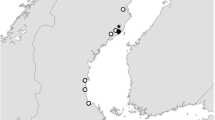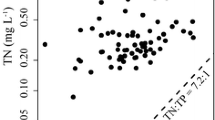Abstract
We have evaluated photoeffects of UV-B, UV-A and PAR radiation on dissolved organic matter (DOM). Photochemical production of dissolved inorganic carbon (DIC) was measured in sterile lake water from Sweden and Brazil after 6 hours of sun exposure. Tubes were exposed to four solar radiation regimes: Full-radiation, Full-radiation minus UV-B, Full-radiation minus UV-B and UV-A (PAR) and darkness.
In both areas, lakes with most DOC (varying between 3 and 40 mg C l-1) were highly humic, resulting in high UV-B attenuation coefficients (Kd = 5–466 m-1). Under Full-radiation, photooxidative DIC-production varied from 0.09 to 1.7 mg C l-1per 6 h, without UV-B from 0.07 to 1.4 mg C l-1 and with PAR only from 0.02 to 0.7 mg C l-1. UV-B radiation explains a minor part (17%) of the photoooxidative DIC-production, while UV-A and PAR have larger effects (39% and 44%, respectively). Photooxidation was proportional to DOC-content and DIC-production was positively related to decrease in DOC and to loss of absorbance at 250 nm. There was no significant difference in DOC and radiation normalized DIC-production between Swedish and Brazilian lakes. The UV-B dose during incubations was approximately 3 times higher in Brazil compared to Sweden, while UV-A and PAR doses were similar. We conclude that DOC from tropical and temperate freshwaters do not seem to differ with respect to sensitivity to photooxidation.
Similar content being viewed by others
References
Amon RMW & Benner R (1996) Bacterial utilization of different size classes of dissolved organic matter. Limnol. Oceanogr. 41: 41–51
Bertilsson S & Allard B (1996) Sequential photochemical and microbial degradation of refractory dissolved organic matter in a humic freshwater system. Arch. Hydrobiol. Spec. Issues Advanc. Limnol. 48: 133–141
Fredrik JE & Lubin D (1994) Solar ultraviolet irradiation at Palmer Station, Antarctica. In: Weiler, CS & Penhale PA (Eds) Ultraviolet Radiation in Antarctica: Measurements and Biological Effects, Vol. 62 (pp. 43–81). Antarctic Research Series
Granéli W, Lindell M & Tranvik L (1996) Photooxidative production of dissolved inorganic carbon in lakes of different humic content. Limnol. Oceanogr. 1996: 698–706
De Haan H (1993) Solar UV-radiation penetration and photodegradation of humic substances in peaty lake water. Limnol. Oceanogr. 38: 1072–1076
Herndl GJ, Müller-Niklas G & Frick J (1993) Major role of ultraviolet-B in controlling bacterioplankton growth in the surface layer of the ocean. Nature 361: 717–719
Kirk JTO, Hargreaves BR, Morris DP, Coffin RB, David B, Frederickson D, Karentz D, Lean DRS, Lesser MP, Madronich S, Morrow JH, Nelson NB & Scully NM (1994) Measurements of UV-B radiation in two freshwater lakes: An instrument comparison. Arch. Hydrobiol. Beih. Ergebn. Limnol. 43: 71–99
Kieber RJ, Zhou X & Mopper K (1990) Formation of carbonyl compounds from UV-induced photodegradation of humic substances in natural waters: Fate of riverine carbon in the sea. Limnol. Oceanogr. 35: 1503–1515
Lindell M, Granéli W & Tranvik L (1995) Enhanced bacterial growth in response to photochemical transformation of dissolved organic matter. Limnol. Oceanogr. 40: 195–199
Lindell M, Granéli W & Tranvik L (1996) Effects of solar radiation on bacterial growth in lakes of different humic content. Aquatic Microb. Ecol. 11(2): 135–141
Miller, WL & Zepp RG (1995) Photochemical production of dissolved inorganic carbon from terrestrial organic matter: Significance to the oceanic organic carbon cycle. Geophysical Research Letters 22: 417–420
Mopper K, Zhou X, Kieber RJ, Kieber DJ, Sikorski RJ & Jones RD (1991) Photochemical degradation of dissolved organic carbon and its impact on the oceanic carbon cycle. Nature 353: 60–62
Nielsen T (1996) Effects on Ultraviolet Radiation on Marine Phytoplankton. PhD thesis. Lund University
Salonen K & Vähätalo A (1994) Photochemical mineralisation of dissolved organic matter in Lake Skjervatjern. Environ. Int. 20: 307–312
Schindler DW, Jefferson Curtis P, Parker BR & Stainton M (1996) Consequences of climate warming and lake acidification for UV-B penetration in North American boreal lakes. Nature 379: 705-708
Scully NM & Lean DRS (1994) The attenuation of ultraviolet radiation in temperate lakes. Arch. Hydrobiol. Beih. Ergebn. Limnol. 43: 135–144
Scully NM, McQuenn DJ, Lean DRS & Cooper WJ (1996) Hydrogen peroxide formation: The interaction of ultraviolet radiation and dissolved organic carbon in lake waters along a 43–75° N gradient. Limnol. Oceanogr. 41(3): 540–548
Sieracki ME, Sieburth JM (1986) Solar radiation-induced growth delay of marine bacteria in filtered seawater. Mar Ecol Prog Ser 33: 19–27
Strome DJ & Miller MC (1978) Photolytic changes in dissolved humic substances. Verh. Internat. Verein. Limnol. 20: 1248–1254
Thurman EM (1985) Organic Geochemistry of Natural Waters. Martinus Nijholt/Dr. Junk
Tranvik LJ (1988) Availability of dissolved organic carbon for planktonic bacteria in oligotrophic lakes of differing humic content. Microbial Ecology 16: 311–322
Tranvik LJ (1990) Bacterioplankton growth on fractions of dissolved organic carbon of different molecular weights from humic and clear waters. Appl. Environ. Microbiol. 56(6): 1672–1677
Valentine RL & Zepp RG (1993) Formation of carbon monoxide from the photodegradation of terrestrial dissolved organic carbon in natural waters. Environ. Sci. Tech. 27(2): 409–412
Wetzel RG, Hatcher PG & Bianchi TS (1995) Natural photolysis by ultraviolet irradiance of recalcitrant dissolved organic matter to simple substrates for rapid bacterial metabolism. Limnol. Oceanogr. 40: 1369–1380
Author information
Authors and Affiliations
Corresponding author
Rights and permissions
About this article
Cite this article
Granéli*, W., Lindell, M., de Faria, B.M. et al. Photoproduction of dissolved inorganic carbon in temperate and tropical lakes – dependence on wavelength band and dissolved organic carbon concentration. Biogeochemistry 43, 175–195 (1998). https://doi.org/10.1023/A:1006042629565
Issue Date:
DOI: https://doi.org/10.1023/A:1006042629565




